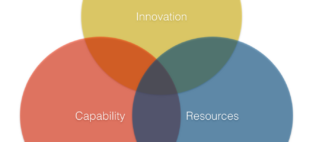Over the years, I’ve worked with many organisations who felt blindsided by events they believed were unforeseeable. Time and again, I’ve seen how people mistake uncertainty for unpredictability—and how that misunderstanding leads to inaction. The truth is, while we can’t always know what’s coming, we can absolutely prepare for a range of possibilities. That’s why I created The Future Matrix.
This tool wasn’t born out of theory, but necessity. I was frustrated by how often good planning was abandoned simply because traditional scenario planning took too long to implement. By the time a robust set of scenarios had been produced, the situation had often already changed. I needed something quicker, more practical—a way to rapidly map out different futures and identify what needed to be done today to be ready for any of them.
From Predicting to Preparing
Many organisations still build their strategies around a single forecast—the one they believe is most likely. It’s a comforting illusion, but it’s a dangerous one. Our world is too interconnected, too volatile, for that kind of narrow thinking. Whether it’s market shifts, leadership changes, supply chain interruptions or social transformations, the variables we face are too numerous to bet everything on one version of the future.
What I advocate for instead is a shift in mindset: from trying to predict the future, to preparing for several futures. The Future Matrix is my way of helping individuals and teams do just that, in a way that’s quick enough to keep up with the pace of change and practical enough to apply to real operational decisions.
Start with What Matters
The process begins simply: ask yourself, “What factors—positive or negative—could affect our situation?” Don’t judge or prioritise yet, just gather. Once you’ve listed these, the next step is to classify them by their impact and the degree of control you have over them. This is where clarity begins to emerge.
The real power lies in focusing on those factors that are high impact and low control—and asking which ones are most likely to occur. These become the foundation of your matrix.
Let’s say you choose two such factors: market confidence and resource availability. When placed on a two-by-two grid, they generate four distinct scenarios. Each one is a version of the future you might find yourself in. Crucially, each one requires a different strategic approach.
Stories Make Strategy Real
Once you have your matrix, the work really begins. You need to bring each future to life. Write short, vivid stories—give them names if it helps. In one scenario, you might be in a booming market but struggling with scarce talent. In another, demand might be down but your internal operations are running smoothly. In each case, what will success require? What will you need to defend against?
These stories aren’t just imaginative exercises—they’re strategic tools. They help you and your team see beyond the default assumptions. They foster a shared understanding of what could happen, and what that would mean for your people, your operations, and your goals.
Planning That’s Dynamic, Not Static
What I love about this process is that it doesn’t just create a plan—it builds readiness. Each scenario leads to concrete actions: contingency plans, monitoring metrics, communication strategies, budget decisions. You’re not just reacting when things go wrong—you’re acting in ways that are coherent with the reality you’re in.
And because this is a living tool, you can keep adjusting as new information comes in. You revisit your matrix regularly. You ask: are these still the right factors? Have our assumptions changed? Are we still in the same quadrant we were three months ago?
It becomes a rhythm, a discipline of attention and reflection that sharpens your responsiveness over time.
The Culture of Preparedness
What I’ve seen, time and again, is that the organisations who embrace this approach don’t just become more resilient—they become more confident, more collaborative, and more innovative. Why? Because their people feel informed and empowered. They know what story they’re in, and they know what to do about it.
In one case, I worked with a manufacturing business facing serious concerns about fluctuating exchange rates and unpredictable demand for new products. By using The Future Matrix, we explored four different outcomes and planned accordingly. When one of those scenarios began to materialise, they didn’t panic—they adjusted. They had already discussed the implications, already mapped their responses, and could act with speed and clarity. That’s the power of preparation.
A Final Thought
We live in a world where change is the only constant. Hoping for the best is not a strategy. Ignoring the signs doesn’t make the risks go away. But facing uncertainty with structured curiosity and practical preparation—that’s a strategy. One that works.
I often say that The Future Matrix is like a pair of binoculars. It won’t change the weather, but it helps you see what’s coming—and that gives you the time to take shelter, change course, or seize an opportunity others may miss.
So my invitation to you is simple: don’t just plan for one future. Plan for all of them. Click here to find out more




